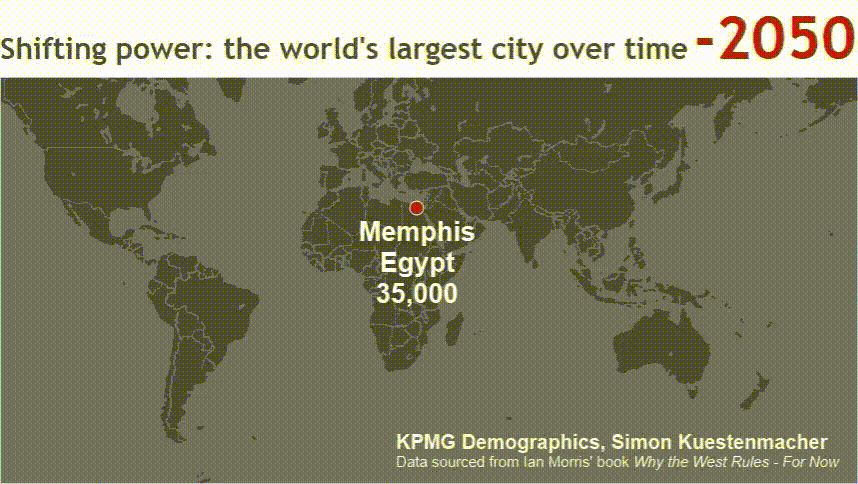
“When Rome fell….” The expression seems designed to conjure the Tarot card Tower that illustrates it, a sudden attack, a reckoning. “Fell,” in the case of most ancient empires, means declined, changed, and transformed over centuries. As all great cities do, Rome suffered many violent shocks during its fall, as it transitioned from a pagan to a Christian empire. The sacking of Rome in 410 left Romans reeling, trying to make meaning from upheaval. They found it in the pagan religion of their ancestors.
To which the defender of the one true faith—by his lights—Augustine of Hippo, answered with a rather odd defense of the new order. Rather than write a theological treatise or a fire-and-brimstone sermon, though it is these things as well, he wrote a book about cities: the City of God, pitted against the Earthly City (which is, you guessed it, aligned with the Devil). The medieval idea of cities as vehicles for the grudge matches of princes must have derived from this strange text, as well as from the emergent feudal order that turned dismembered empires into uneasy patchworks of cities. Rome didn’t fall, it decentralized, diversified, and propagated.
Augustine saw the city not only as a metaphor but also as the height of human power: doomed to fall in the final analysis, yet built to pose a formidable challenge to divine rule. But what is a city? Is it merely a stronghold for corruption and commerce or something more righteous? Is it an expression of class power, the worker bees who run it or just cogs in a machine, a la Metropolis? Is it an “assemblage,” defined by Gilles Deleuze and Felix Guattari as “a multiplicity which is made up of many heterogenous terms and which establishes liaisons, relations between them, across ages, sexes and reigns”?
In our post-post-modern moment, we find all of these ideas—the hierarchical and the horizontal—operating. Popular books like Ian Morris’s Why the West Rules—For Now seem to spring from an impulse common to apologists and secularists alike—the will to linear certainty. There is a sense in which 21st century thought has turned back to theology, stripped of the trappings of belief, to make sense of the rise and decline of the West. This faith demands not blind allegiance, but data, more and more and more data—to answer the burning question of 2001’s Planet of the Apes: “How’d these apes get like this?”
Then there’s the internet—a space for sharing gifs, a functional assemblage, and maybe someday, a city. Global circumstances seem to warrant reflection. Like the Romans, we want a story about how it came to pass, and we want to make and share animated infographic gifs about it. The gif at the top of the post is such a gif. Drawing on the sweeping, several-thousand-year historical argument of Morris’s book, and data from the UN Population Division, its creator whisks us through a visual narrative of supremacy-by-city over the course of roughly four-thousand years.
Sheer size, in this visual account, determines the winners—a simplistic criteria, but the model here is simplified for effect. It dramatizes arguments made and data gathered elsewhere. To get the full effect, you’d probably do well to read Morris’s book and, while you’re reaching for your wallet, the original article, behind a paywall at The Australian, for which this gif was made. Its title? “Why Rome is the World’s Best City.” The gif’s designer admits in a Reddit post, “We are dealing with historic demographic data here which are always debated among scholars…. I acknowledge that other scholars would add or delete certain cities that pop up in my map.”
For more on the idea of the city as assemblage, see European Graduate School professor Manuel DeLanda’s lecture “A Materialist History of Cities” and his book Assemblage Theory. Augustine insisted we view the city through the eye of faith—his faith. In the 21st century, DeLanda’s intellectual gestures, like Morris’s, are as grand, but he suggests throwing out Western schematics in a return to earlier religious practices. To understand a city, he suggests, we might need “tools to manipulate these intensities… in the form of a growing variety of psychoactive chemicals that can be deployed to go beyond the actual world, and produce at least a descriptive phenomenology of the virtual.”
Related Content:
Get the History of the World in 46 Lectures, Courtesy of Columbia University
Watch the History of the World Unfold on an Animated Map: From 200,000 BCE to Today
A Crash Course in World History
Josh Jones is a writer and musician based in Durham, NC. Follow him at @jdmagness


Leave a Reply